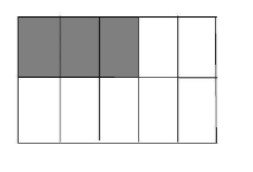
What fraction does the shaded part represent?

A. $\dfrac{3}{5}$
B. $\dfrac{2}{5}$
C. $\dfrac{3}{10}$
D. $\dfrac{2}{10}$

Answer
580.8k+ views
Hint:As everything is equally divided, we can say that the fraction of shaded region is equal to the number of shaded parts divided by the number of total parts that are present in the diagram.
Complete step-by-step answer:
Let us draw the diagram firstly,

Now we can go on explanation.
In the given diagram, we can clearly see the outer rectangle.
This rectangle is subdivided into ten equal parts.
Here by the term equal parts mean that the area of each part is the same.
So, we can say that the fraction of each part is the one divide by the total number of parts.
Hence,
The fraction of one single part $ = \dfrac{1}{{10}}$
Up to now everything is clear. Now look at the number of shaded parts in the diagram.
The number of shaded parts in the diagram $ = 3$
In order to get the fraction of all the shaded parts,
Let us multiplate the fraction of a single part with the number of shaded parts.
The fraction of shaded region $ = 3 \times \dfrac{1}{{10}}$
$ = \dfrac{3}{{10}}$
So, we got the solution for the fraction of the shaded part as $\dfrac{3}{{10}}$.
So, the correct answer is “Option C”.
Note:These kinds of problems are very simple. But remember one thing that sometimes the parts in the diagram will be not equally divided. In that case you need to find out the proportions in which they are divided and then after only you can say that the fraction of shaded region is equal to the number of shaded parts divided by the total number of parts. And that too, you should make sure that all the parts are of equal size and shape.
Complete step-by-step answer:
Let us draw the diagram firstly,

Now we can go on explanation.
In the given diagram, we can clearly see the outer rectangle.
This rectangle is subdivided into ten equal parts.
Here by the term equal parts mean that the area of each part is the same.
So, we can say that the fraction of each part is the one divide by the total number of parts.
Hence,
The fraction of one single part $ = \dfrac{1}{{10}}$
Up to now everything is clear. Now look at the number of shaded parts in the diagram.
The number of shaded parts in the diagram $ = 3$
In order to get the fraction of all the shaded parts,
Let us multiplate the fraction of a single part with the number of shaded parts.
The fraction of shaded region $ = 3 \times \dfrac{1}{{10}}$
$ = \dfrac{3}{{10}}$
So, we got the solution for the fraction of the shaded part as $\dfrac{3}{{10}}$.
So, the correct answer is “Option C”.
Note:These kinds of problems are very simple. But remember one thing that sometimes the parts in the diagram will be not equally divided. In that case you need to find out the proportions in which they are divided and then after only you can say that the fraction of shaded region is equal to the number of shaded parts divided by the total number of parts. And that too, you should make sure that all the parts are of equal size and shape.
Recently Updated Pages
Master Class 6 English: Engaging Questions & Answers for Success

Master Class 6 Social Science: Engaging Questions & Answers for Success

Master Class 6 Maths: Engaging Questions & Answers for Success

Master Class 6 Science: Engaging Questions & Answers for Success

Class 6 Question and Answer - Your Ultimate Solutions Guide

Master Class 10 General Knowledge: Engaging Questions & Answers for Success

Trending doubts
How many millions make a billion class 6 maths CBSE

How many seconds are there in an hour class 6 maths CBSE

Give 10 examples for herbs , shrubs , climbers , creepers

What is meant by the term Universal Adult Franchis class 6 social science CBSE

Why is the Earth called a unique planet class 6 social science CBSE

Why is democracy considered as the best form of go class 6 social science CBSE





